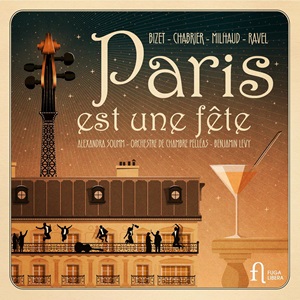
Paris est une fête
Darius Milhaud (1892-1974)
Le Bœuf sur le toit – cinéma-fantaisie for violin and orchestra (1919)
Emmanuel Chabrier (1841-1894)
Bourrée fantasque (1891) orch. Thibault Perrine (b.1979)
Maurice Ravel (1875-1937)
Tzigane – rhapsodie de concert for violin and orchestra (1924)
Georges Bizet (1838-1875)
Symphony in C major (1855)
Alexandra Soumm (violin), Orchestra de chambre Pelléas/Benjamin Levy
rec. 2021 Salle Colonne, Paris
Fuga Libera FUG813 [66]
Paris may be a party, as Hemingway would have it. But Milhaud’s vibrantly colourful fantasy Le Bœuf sur le toit, the ox on the roof, is a homage to a land on the other side of the Atlantic Ocean, Brazil, its dances and its music. Milhaud had lived there for two years from 1917 and the fantasy was completed by the end of 1919. Originally intended as a possible accompaniment for a silent Charlie Chaplin film, it was adapted into a surreal ballet by Jean Cocteau. That was how it was originally heard, but there are arrangements for violin and orchestra, violin and piano and two pianos by the composer himself. Milhaud tied the piece together with the vigorous theme that is heard at the very opening of the work, a theme that recurs many times – I haven’t counted how many. The often acerbic and polyrhythmic music that follows takes twenty themes from, at last count, fourteen Brazilian composers. According to Milhaud the name comes from a popular Brazilian hit O boi no telhado and in 1921 after the success of the ballet a Parisian club, a favourite haunt of Cocteau and his companions, took the name as its own. It is hard not to get swept away with the infectious and kaleidoscopic nature of the music, driven and hard edged one minute and as delicate as a lullaby the next. Just listen to how violinist Alexandra Soumm coaxes with her harmonics at around 6:40. She plays the version with Arthur Honegger’s cadenza.
Milhaud brought the party back from Brazil and with Cocteau’s help kicked off proceedings in Paris and in party fashion we move from cinéma-fantaisie to dance fantasy; Bourrée fantasque to be exact, Chabrier’s wonderfully madcap piano solo that was to be his final work for the instrument. He left behind unfinished but precise sketches for an orchestration of the work and it is these that have guided the skilful orchestration by Thibault Perrine, commissioned by Benjamin Levy for the Pelléas orchestra. It is lighter in feel than the orchestration by Felix Mottl, the former version of choice. It has so many felicitous touches that make it a delight – the solo instruments in the molto moderato sections, brass trills and delicate glockenspiel toward the end or indeed any of the percussion writing. The orchestra sound like they’re having a ball. Ms Soumm catches up with the party, along with the bohemian contingent, announcing herself with the grand entrance that is the opening of Tzigane and what an entrance; spectacular virtuosity on display but more than that is the swagger and panache that she brings to the music … and what bite she brings to those rhapsodic opening phrases! This is the first recording of the new Ravel edition of the score; the booklet and Rob Maynard’s excellent earlier review provide more information about this.
Benjamin Levy and his chamber players go on to show us that Bizet could have been well into the party celebrations far earlier than any of the other contributors here, had his sparkling symphony in C not lain unheard until 1935. An astonishing work for a seventeen-year-old student that has far outstripped the work that inspired it, his teacher Gounod’s first symphony, in popularity. It may reference that work and it may be closely fashioned on classical models, but the joy that infuses each movement is every bit as infectious as anything else on this disc. In the first movement Bizet, even as a student, shows just how much mileage you can get out of something as simple as a broken chord, the work’s opening phrase, if you know what you are doing. And Bizet certainly does, propelling the piece forward while leaving plenty of time for instrumental interplay. It is pretty high energy and the slow movement offers a welcome respite in the form of a wonderfully melancholic melody on the oboe over a gently lilting pizzicato accompaniment, a true highlight of the symphony. I was going to continue the party analogy with the suggestion that the fugue in the middle of the movement, an idea borrowed from Gounod’s symphony, perhaps evokes a shy academic dad-dancing in the corner. But I have decided not to, you’ll be pleased to hear. More party guests are arriving; we have Parisians, Brazilians and Slavs and now the high kicking third movement announces the arrival of Scottish revellers, their highland fling getting everyone dancing – they’ve even brought a bagpiper whose drone is heard in the trio. The finale is what got me toe-tapping for ages when I first heard this symphony many, many years ago and it still never fails to bring a smile to my face and a tap to my toe.
Aiding and abetting in that toe-tapping is the accomplished playing of the twenty-year-old Pelléas orchestra, who respond to the flighty changes of mood with precision and clarity. They have fire aplenty to complement Alexandra Soumm in the Ravel and find the myriad colours in the orchestrations of Chabrier and Milhaud. These elements are finely balanced with a lightness of touch when needed in the Bizet that is surely a hallmark of their playing. I fine party to which I’m glad I was invited.
Rob Challinor
Previous review: Rob Maynard (September 2024)
Buying this recording via a link below generates revenue for MWI and helps us keep free access to the site




















